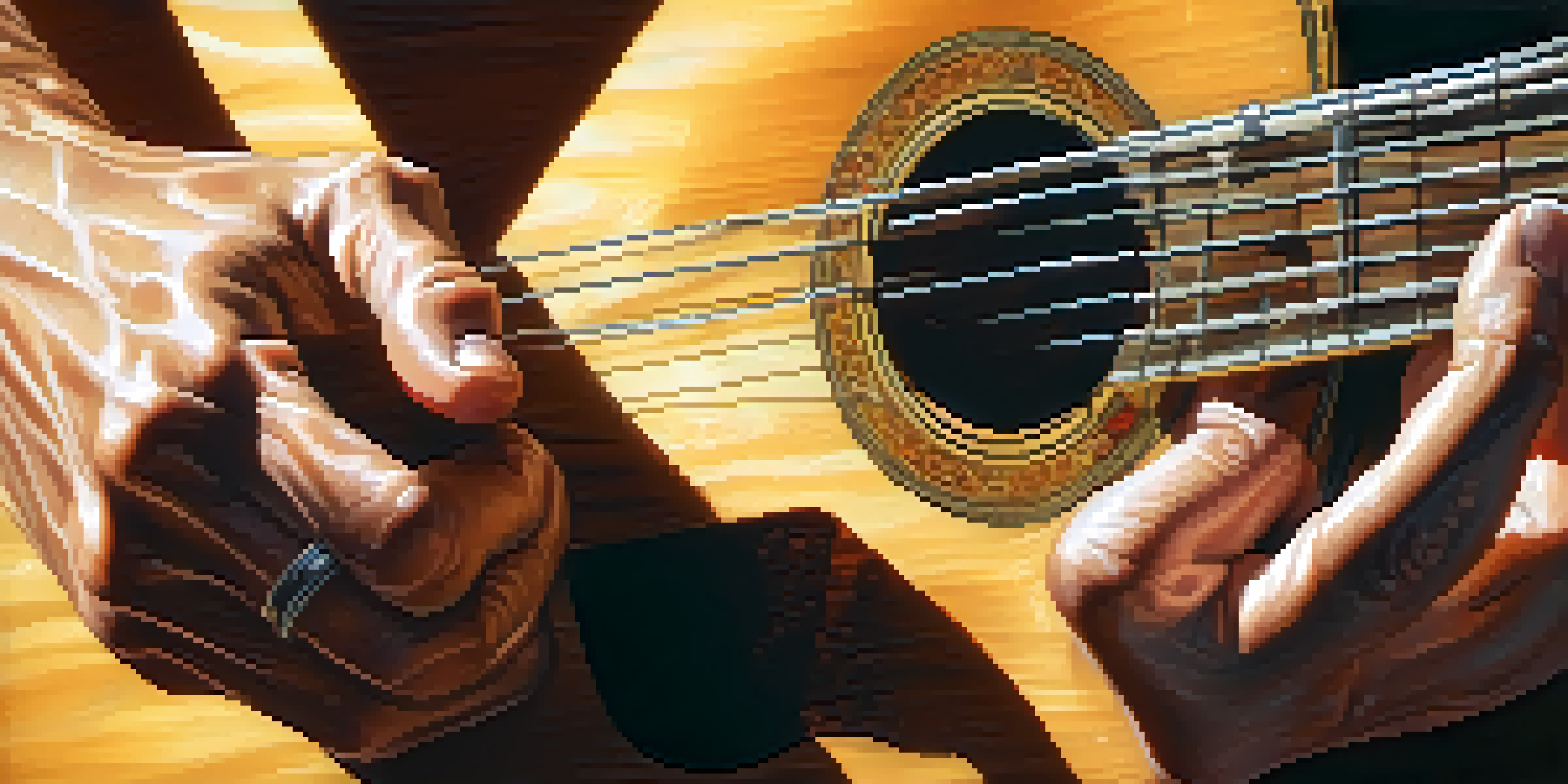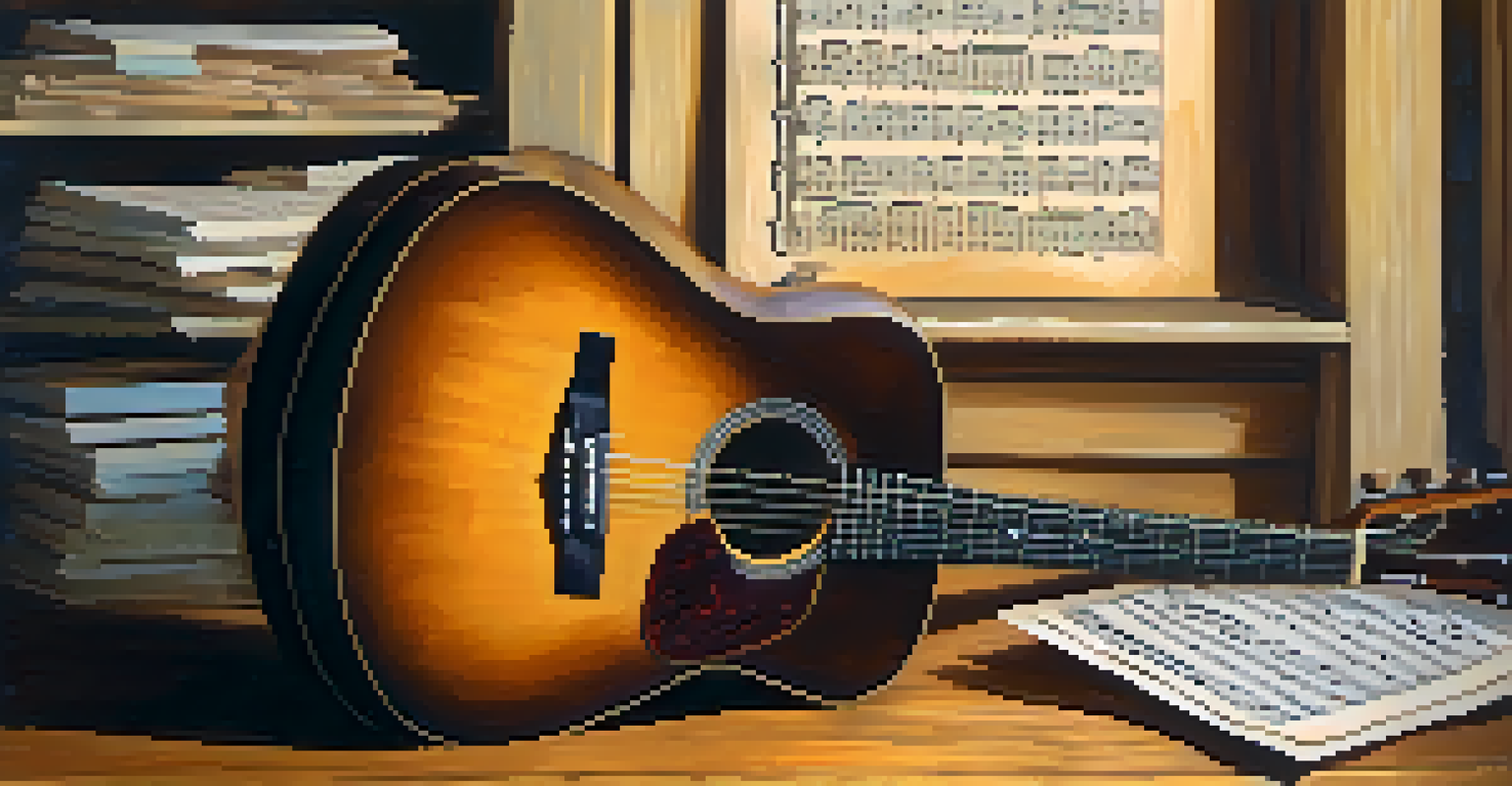Exploring Guitar Techniques for Enhanced Musical Expression

Understanding the Basics of Guitar Techniques
Before diving into advanced techniques, it's essential to grasp the basics. Fundamental skills such as strumming, fingerpicking, and fretting form the backbone of guitar playing. Like building a house, your musical expression relies on a strong foundation of these core techniques.
Music is the shorthand of emotion.
Once you have a handle on the basics, you can begin to explore how they can enhance your musical phrases. Each technique offers a different flavor or emotion to your playing. This exploration can lead to a more personalized and expressive sound.
Remember, every guitarist has their own unique style. Experimenting with basic techniques allows you to discover what resonates most with you, paving the way for deeper musical expression.
The Art of Fingerpicking for Emotional Depth
Fingerpicking is a technique that can add intricate layers to your music. By plucking the strings with your fingers instead of a pick, you create a softer, more nuanced sound. This method allows for more control over dynamics, letting you convey emotion more effectively.

Consider the way a gentle breeze can stir leaves compared to a strong wind. Fingerpicking provides that gentle touch, enabling you to evoke feelings of serenity or melancholy in your playing. It's a great way to connect with your audience on an emotional level.
Mastering Basic Techniques First
Fundamental skills like strumming and fingerpicking form the essential foundation for all guitar playing.
To get started, practice simple patterns before incorporating them into your favorite songs. As you become more comfortable, you'll find your own unique fingerpicking style, enhancing your overall musical expression.
Enhancing Expression with Vibrato Techniques
Vibrato is a powerful technique that adds warmth and life to your notes. By slightly bending the pitch of a note back and forth, you can create a more expressive sound that captures listeners' attention. It’s like adding a dash of spice to a dish — it heightens the flavor.
The guitar is a miniature orchestra in itself.
Different types of vibrato exist, including wide, narrow, and slow variations. Each offers its own emotional quality, allowing you to express joy, sorrow, or tension. Experimenting with these styles can enrich your musical storytelling.
To practice vibrato, start with a single note and focus on controlled movement. As you master it, you’ll find that your ability to convey emotion through your guitar playing improves significantly.
Using Hammer-Ons and Pull-Offs for Fluidity
Hammer-ons and pull-offs are techniques that can create fluid, legato phrases in your playing. A hammer-on involves striking a string with a finger while pulling off creates a smooth transition between notes. These techniques can help you move effortlessly between notes, enhancing the musical flow.
Think of it like a flowing river — the water moves seamlessly, creating a beautiful, continuous sound. Similarly, using hammer-ons and pull-offs can help you achieve a more melodious and expressive performance.
Combine Techniques for Unique Sound
Blending various guitar techniques allows you to create a distinctive musical style that reflects your identity.
To incorporate these techniques, start slow and focus on accuracy. Gradually increase your speed, and you'll find that your playing becomes more fluid and expressive over time.
Exploring Slide Guitar for Unique Textures
Slide guitar is a unique technique that adds a distinct texture to your music. By using a slide, you can glide between notes, creating a smooth, almost vocal-like quality. This technique is particularly effective in genres like blues and country.
Imagine a singer who uses their voice to slide between notes, creating emotion and depth. Slide guitar captures a similar essence, allowing you to express feelings that might be hard to convey with standard playing methods.
To get started, choose a glass or metal slide and practice on a single string. As you gain confidence, explore incorporating slides into your favorite songs for added depth and character.
Incorporating Harmonics for Ethereal Sounds
Harmonics are an often-overlooked technique that can add an ethereal quality to your music. By lightly touching the string at specific points while plucking, you create a bell-like tone that can enhance your overall sound. It’s like finding hidden treasures in your music.
These high-pitched notes can be used for accents or to create a dreamy atmosphere in your playing. They can be particularly effective in quieter, more introspective pieces where you want to evoke a sense of wonder.
Use Techniques to Enhance Emotion
Techniques like fingerpicking and vibrato can add emotional depth and expression to your guitar playing.
To practice harmonics, start with the twelfth fret, where they are easiest to produce. As you become familiar with the technique, don’t hesitate to experiment with different frets and songs.
Mastering Alternate Picking for Precision
Alternate picking is a technique that enhances your speed and precision. By alternating between downstrokes and upstrokes, you can play faster and more efficiently. This technique is particularly useful in genres like rock and metal, where speed is often essential.
Imagine a sprinter using a rhythmic pattern in their stride to increase their speed. Similarly, alternate picking can propel your playing forward, allowing you to tackle complex passages with ease.

To develop your alternate picking, practice simple scales and gradually increase your speed. Over time, you’ll notice a significant improvement in your overall guitar playing.
Combining Techniques for Unique Musical Styles
The beauty of guitar playing lies in the ability to combine various techniques for a unique sound. By blending fingerpicking with slide guitar or harmonics with vibrato, you can create a personal style that reflects your musical identity. It’s like mixing colors on a palette to create a masterpiece.
As you experiment with different combinations, you'll discover new ways to express yourself. Just like a chef tries new ingredients to create a delicious dish, finding your unique blend of techniques can lead to exciting musical discoveries.
Master Basic Techniques First
Fundamental skills like strumming and fingerpicking form the essential foundation for expressive guitar playing.
Don’t be afraid to break the rules! The most memorable musical moments often come from unexpected combinations, so let your creativity guide you on your guitar journey.